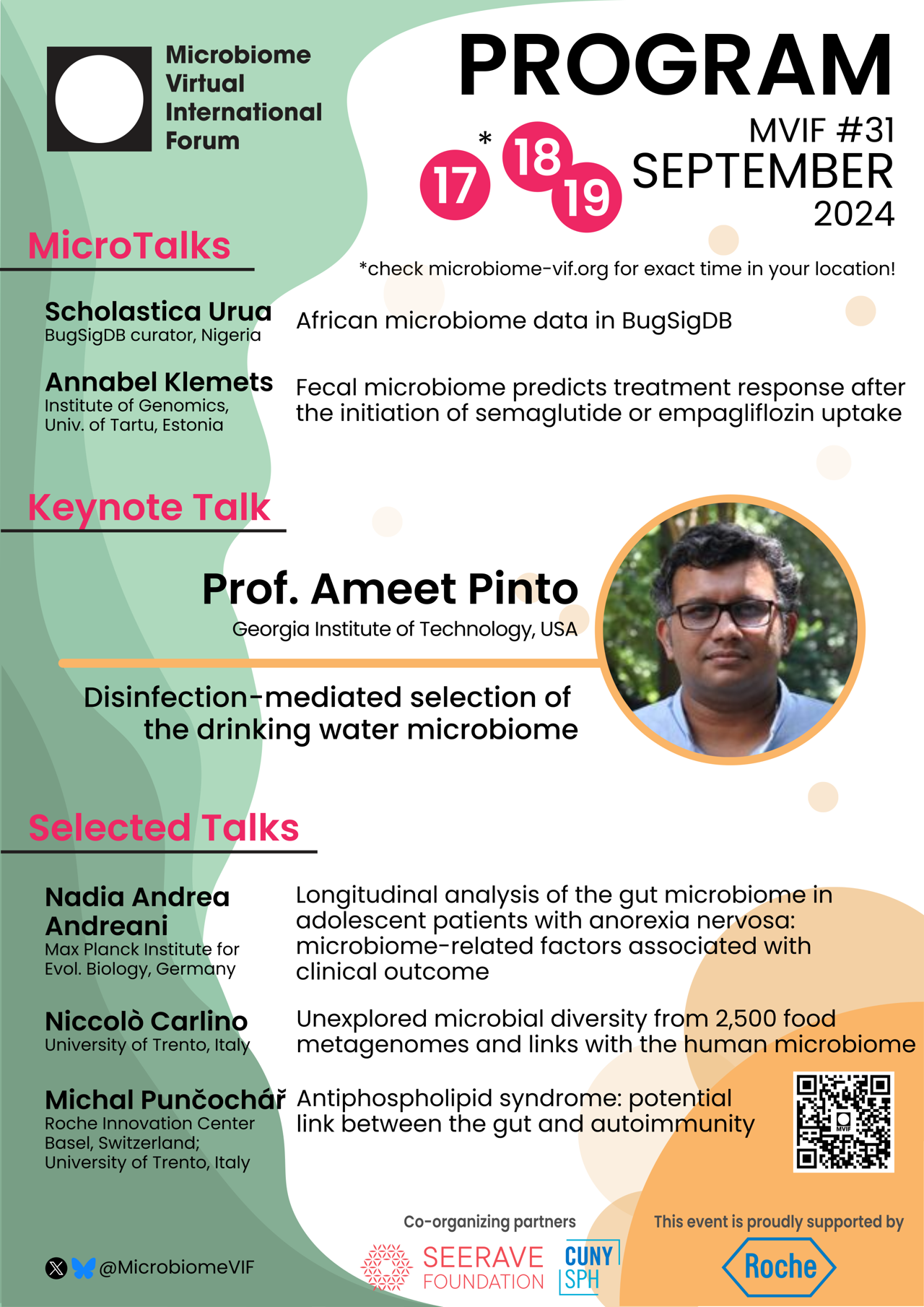Keynote
Disinfection-mediated selection of the drinking water microbiome
by Prof. Ameet Pinto
Most microbes in drinking water do not pose a human health risk, but the presence of pathogenic microbes can have severe public health implications. Hence, nearly all drinking water treatment technologies designed to manage microbial communities are intended to either inactivate, starve, or remove microorganisms during treatment and minimize growth during water distribution. Yet, every liter of drinking water can contain tens of millions of diverse microorganisms. How does the drinking water microbiome persist within the drinking water distribution systems despite chronic disinfectant stress and nutrient deprivation? This talk will present hypotheses based on field data on potential ecological and physiological mechanisms underpinning the persistence (and sometimes proliferation) of the drinking water microbiome. Systematically testing these hypotheses under field-relevant conditions has the potential to shift our approaches to microbial management of drinking water systems from a pathogen-centric to a microbiome-inclusive framework.
MicroTalks
African microbiome data in BugSigDB
The complexity and diversity in microbiome research pose difficulties in consolidating and evaluating existing knowledge. BugSigDB, an open-source and open-science platform (https://bugsigdb.org) powered by the same technology as Wikipedia, is designed to address this issue through standardized recording of key methods and signatures in published microbiome literature. BugSigDB is maintained by a global network of hundreds of curators, including many from Africa, fostering a more comprehensive understanding of health and disease and encouraging more inclusive and impactful research results. Currently, BugSigDB includes microbiome data of 39 studies conducted in 18 African countries, out of a total of 1174 curated studies from 78 countries. The goal of the presented work is to increase the curation of microbiome studies involving African participants, thereby enriching the global dataset and ensuring that African data is adequately represented in microbiome research.
Scholastica Urua, BugSigDB curator, Nigeria
Fecal microbiome predicts treatment response after the initiation of semaglutide or empagliflozin uptake
The gut microbiome has been shown to be affected by the use of many human-targeted medications, and the interaction can be bidirectional. This has been clearly demonstrated for type 2 diabetes medications that have been in clinical use for several decades. However, the bidirectional effects of novel type 2 diabetes drugs semaglutide, empagliflozin, and the gut microbiome have yet to be clearly described. Considering this, we investigate the effect of semaglutide and empagliflozin initiation on the gut microbiome of type 2 diabetes patients. In addition, we analyze whether the pre-treatment gut microbiome can predict the treatment efficacy.
In the study, patients with type 2 diabetes donated gut microbiome fecal samples at four timepoints (Baseline, Month 1, Month 3; Month 12) that were studied using 16S ribosomal RNA gene sequencing and analysis. Subjects additionally donated plasma and urine samples for quantitative measurement of clinical markers before treatment initiation and at Months 3 and 12. Repeated measures ANOVA paired with paired t-tests were used to analyze the effects of drug initiation on the gut microbiome. Pearson correlation was used to identify microbial features associated with the change in clinical parameters.
First, semaglutide and empagliflozin use is associated with changes in the gut microbiome after treatment initiation, but changes in microbial diversity were not detected. Moreover, the baseline gut microbiome predicted changes in glycohemoglobin for semaglutide and empagliflozin users.
Based on the results, our findings suggest that semaglutide and empagliflozin impact the gut microbial community during treatment. In addition, the baseline gut microbiome can predict semaglutide treatment effects.
Annabel Klemets, Institute of Genomics, University of Tartu, Estonia
Link to OA paper: https://doi.org/10.1101/2024.07.19.24310611
Selected Talks
Longitudinal analysis of the gut microbiome in adolescent patients with anorexia nervosa: microbiome-related factors associated with clinical outcome
There is mounting evidence regarding the role of gut microbiota in anorexia nervosa (AN). Previous studies have reported that patients with AN show dysbiosis compared to healthy controls (HCs), however, the underlying mechanisms are unclear, and data on influencing factors and longitudinal course of microbiome changes are scarce. Here, we present longitudinal data of 57 adolescent inpatients diagnosed with AN at up to nine time points (including a 1-year follow-up examination) and compare these to up to six time points in 34 HCs. 16S rRNA gene sequencing was used to investigate the microbiome composition of fecal samples, and data on food intake, weight change, hormonal recovery (leptin levels), and clinical outcomes were recorded. Differences in microbiome composition compared to HCs were greatest during acute starvation and in the low-weight group, while diminishing with weight gain and especially weight recovery at the 1-year follow-up. Illness duration and prior weight loss were strongly associated with microbiome composition at hospital admission, whereas microbial changes during treatment were associated with kilocalories consumed, weight gain, and hormonal recovery. The microbiome at admission was prognostic for hospital readmission, and a higher abundance of Sutterella was associated with a higher body weight at the 1-year follow-up. Identifying these clinically important factors further underlines the potential relevance of gut microbial changes and may help elucidate the underlying pathophysiology of gut-brain interactions in AN. The characterization of prognostically relevant taxa could be useful to stratify patients at admission and to potentially identify candidate taxa for future supplementation studies aimed at improving AN treatment.
Nadia Andrea Andreani, Max Planck Institute for Evolutionary Biology, Germany
Link to OA paper: https://www.tandfonline.com/doi/full/10.1080/19490976.2024.2304158
Unexplored microbial diversity from 2,500 food metagenomes and links with the human microbiome
Complex microbiomes are part of the food we eat and influence our own microbiome, but their diversity remains largely unexplored. Here, we generated the open access curatedFoodMetagenomicData (cFMD) resource by integrating 1,950 newly sequenced and 583 public food metagenomes. We produced 10,899 metagenome-assembled genomes spanning 1,036 prokaryotic and 108 eukaryotic species-level genome bins (SGBs), including 320 previously undescribed taxa. Food SGBs displayed significant microbial diversity within and between food categories. Extension to >20,000 human metagenomes revealed that food SGBs accounted on average for 3% of the adult gut microbiome. Strain-level analysis highlighted potential instances of food-to-gut transmission and intestinal colonization (e.g., Lacticaseibacillus paracasei) as well as SGBs with divergent genomic structures in food and humans (e.g., Streptococcus gallolyticus and Limosilactobabillus mucosae). The cFMD expands our knowledge on food microbiomes, their role in shaping the human microbiome, and supports future uses of metagenomics for food quality, safety, and authentication.
Niccolò Carlino, Department of Cellular, Computational and Integrative Biology, University of Trento, Trento, Italy
Link to OA paper: https://www.cell.com/cell/fulltext/S0092-8674(24)00833-X
Antiphospholipid syndrome: potential link between the gut and autoimmunity
Michal Punčochář, Roche Pharmaceutical Research and Early Development, Roche Innovation Center Basel, Basel, Switzerland; Department of Computational, Cellular and Integrative Biology, University of Trento, Trento, Italy

